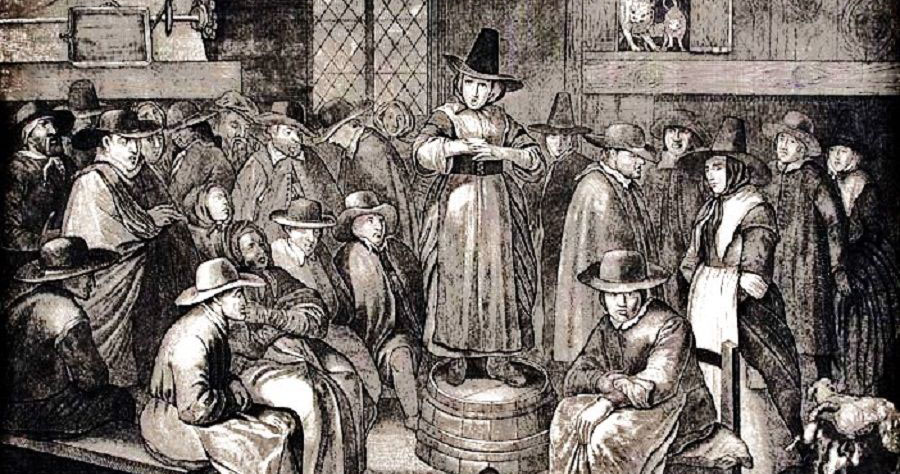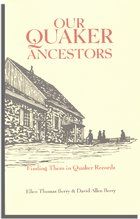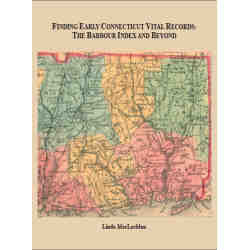
The following article is excerpted from the Introduction to Ellen and David Berry’s book, Our Quaker Ancestors. For more information about that publication, please CLICK HERE.
The Religious Society of Friends, or Quakers, has a rich
storehouse of records kept from its beginning in the mid-1600s to the present.
There are vast differences among Quaker records, and the genealogist must
know which ones to use. The study of Quaker records is mechanically different
from that of other religious organizations. More emphasis must be placed on
historical context, because organizational history and record-keeping
are closely related. Unless you are careful–and knowledgeable–you can become
hopelessly lost and find yourself giving up on one of the richest sources of
genealogical records you could ever hope to find.
Across the U.S. are small towns with names
that have a certain rhythm or quality of sound. As you move south and west from
the eastern seaboard to the Mississippi River and beyond, through Virginia and the swamplands of the Carolinas to Georgia, you will see names like Radnor, Concord,
Salem, New
Garden, Goshen, Cedar Creek, and others which combine
Biblical and geographical origins. These names are a part of one of the most
interesting facets of early American history. They indicate that, at least
at one time, the area was populated by The Religious Society of Friends. The
Quakers were once an influential part of their communities. They moved from
their early settlements in the original eastern colonies and called their new homes
by familiar names, much as they had done when they arrived from England and Wales. In some of these towns, you
might find a rectangular building, usually
stretching east to west and facing
south, which might still be used as a meetinghouse. In all probability, it will
have the same name as the village or
town.
If you were to visit any of these meetinghouses today, you might find a record of almost every event which took place at that location from the time of its establishment. These records include information on births, marriages, and deaths, but they also note the names of residents moving to and from the area and their places of origin, as well as committee actions on a wide variety of topics, including requests to individuals to leave the meeting and the reasons for the request. In addition, there would be records of announced intentions of marriage, followed by the actual wedding record naming not only the bride and groom but all of those present, among whom may be found the parents, brothers, sisters, and perhaps other relations of the newlyweds. If the old records are not at the meetinghouse itself, it is possible to determine where they have been sent and where the original records or microfilm copies can be used by the general public. In other words, you will find a genealogist’s dream. There is an amazing number of these records in existence. You only need to know where they are and how to use them. This is the focus of [our] book.
The Religious Society of Friends began in the same religious turmoil of 17th-century England that produced the Puritans. The Quakers also immigrated to America to escape severe religious persecution. Although Quakers first saw American shores during the 1650s, it was not until 1682 that large numbers started to emigrate from the British Isles and smaller numbers from continental Europe. It was in this year that William Penn landed just south of what is now Philadelphia to exercise his proprietorship of the present states of Pennsylvania and Delaware. Because of their stubbornness or strong-mindedness (depending upon how you view it), the Quakers’ influence far exceeded their numbers. They were a study in contradictions. Although they espoused religious freedom, they required their own members to worship in a specified manner. No organization had more rules regarding removal from approved status than the Quakers. By today’s standards, these rules seem trivial and even arrogant. It now seems ironic that it was precisely this dictatorial image that the Society wanted to avoid at all costs. They were truly “plain people,” but at the same time they were shrewd merchants. Their honesty in personal and business dealings was renowned. Their treatment of the Indians is a classic study in how other white Americans should have conducted themselves. However, even in this area they were not completely faultless. They abhorred slavery, but some families owned slaves. They were against war of any kind, but still some fought in the Revolutionary and Civil Wars.
The Quakers were a more mobile society than most religious groups that came to early America. Whether their travels through the South to the Midwest were prompted by religious fervor, the clash of political and religious beliefs (e.g. slavery), or simply the desire for land and opportunities is now a moot point. The fact is they did move in large numbers, and in doing so they left a trail of records unsurpassed by any other religious organization.

There is another side to this story. The same doctrine that required record-keeping also forbade religious rituals and any form of self-aggrandizement. In the early years even grave markers were prohibited, as were personal histories (although some histories do exist, particularly of people prominent in the movement). Therefore, it is often difficult for a genealogist to place an ancestor in the proper historical perspective. However, the voluminous records more than make up for these deficiencies. It is always safe to say that anyone interested in tracing ancestors is indeed fortunate if a connection can be made with Quakers, for it means there is a good chance that comprehensive primary records can be found.





Thank you so much for this article! I enjoyed it as I come from a long line of Shoemaker Quakers, the first of which came to the US with William Penn. My Dad, the last Quaker in our line, got me started doing genealogy about 14 years ago, and it has been and is still a passion of mine.
Thanks for the feedback. Our e-pub version of Hinshaw’s Quaker Encyclopedia has gotten a lot of use because it is so comprehensive. Continued success with your research.
I have traced my Van de Woestyne, now Vastine, ancestors back to the Pennsylvania Quakers. However, I and everyone else have hit a brick wall when it comes to the migration from Europe (Netherlands). It is with much hope that this book can shed some light finding out more about this branch of my family.
John Vastine, by which name he is known, a descendant of Dutch ancestors, arrived about the time of William Thomas. Before 1690, Abraham Van de Woestyne immigrated from Holland to New York, with his three children, John, Catherine and Hannah. In 1698 we find them at Germantown, where they owned real estate, and the two daughters joined the Society of Friends. About 1720 John sold his land at Germantown and removed to Hilltown, where he bought a considerable tract of Jeremiah Langhorne. His quaint dwelling, long since town down, with gable to the road, stood on the Bethlehem pike, about two miles northwest of Line Lexington and four from Sellersville. His name is found on nearly all the original petitions for opening roads in Hilltown, and on that addressed to the court at Bristol, dated March 8, 1724, from the inhabitants of “Perchichi,”(1) asking that the draft of Hilltown may be recorded, where his name is spelled Van de Woestyne. He died in 1738. The names of three of his children are known, Abraham, Jeremiah and Benjamin. The latter joined the Friends, and in 1730 applied to the Gwynedd monthly meeting for permission to hold meetings in his house. Abigail Vastine, granddaughter of John, the founder of the family, and a woman of great personal beauty, which she inherited from her Holland ancestors, married Andrew Armstrong. John Vastine has numerous descendants in Chester, Northumberland, and other counties in this state, and in Kentucky and some of the Western states.
There is, perhaps, no more curious circumstance connected with the history of names in this State than that relating to this family. The original name was Van de Woestyne, which, in the course of time, by a gradual change in the orthography, became Wostyne, Voshne, Vashtine, and Vastine, as now spelled. The original settler was oftener called “Wilderness” than by any other name, which many supposed was given him because he had pushed his way among the first into the woods. At that day the Dutch and Germans were somewhat in the habit of translating their patronymics into English, and accordingly “Van de Woestyne” became “of the wilderness.” After this the orthography has not much improved, for we find it written Wilderness, Van de Wilderness, etc., etc. Gradually the original name was abandoned altogether, and Vastine adopted in its stead. “ From History of Hill Town, Bucks County, PA
This website may be of interest, in regards to the deeper roots of the Vastines/Van de Woestynes/Van de Woestijns and a castle that was more recently unearthed.
https://www.researchgate.net/publication/297162399_A_previously_unknown_late_14th-century_brick_castle_excavated_at_aalter_Flanders_Belgium_A_burgundian_stronghold_that_lay_between_the_rebellious_flemish_towns_of_ghent_and_bruges
You may find this interesting in your digging on the Van de Woestynes/Vastines/Van de Woestijns. https://www.researchgate.net/publication/297162399_A_previously_unknown_late_14th-century_brick_castle_excavated_at_aalter_Flanders_Belgium_A_burgundian_stronghold_that_lay_between_the_rebellious_flemish_towns_of_ghent_and_bruges
My ancestors were Quaker migrated to Michigan thru Detroit area over and up Michigans West Coast. Spring Lake; Founded Town of Zeeland near Grand Rapids. Consolite to Neatherlands, Queen Willamiena. Steketee, Cornelius, Littlefield. I have medals of Woman’s emancipation organization (voting rights) movement.) very prominent family history Thru to todays time.